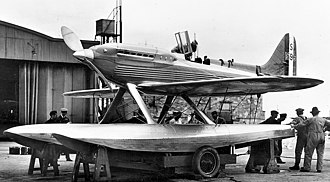
Back منصة عائمة Arabic Понтон (плавателен съд) Bulgarian Pontó Catalan Ponton Czech Ponton Danish Ponton German Pontono Esperanto Pontón (embarcación) Spanish Pontoon Estonian Pontoi Basque

Floats (also called pontoons) are airtight hollow structures, similar to pressure vessels, designed to provide buoyancy in water. Their principal applications are in watercraft hulls, aircraft floats, floating piers, pontoon rhinos, pontoon bridges, and marine engineering applications such as salvage.
During World War II the United States Navy Civil Engineer Corps developed a modular steel box (pontoon) for the Seabees to use. It was a system of pre-drilled pre-cut angle iron and steel plate that could be assembled anywhere for which they became famous.[citation needed] They used them to facilitate amphibious landings. With the pontoons, Seabees assembled docks, causeways, and rhinos to whatever size needed. They allowed landings on Sicily where no one thought possible. They ferried Patton across the Rhine and put Marines ashore on Okinawa. They would be used during the Korean War in the landing at Inchon in 1950 and again in Lebanon during the 1958 Lebanon crisis.
Various objects that make use of floats are often referred to synecdochically as pontoons.